This iteration of the Zed-X received such an overhaul this go �round, during the 2011 model�s recent press introduction at the hilly Road Atlanta race circuit in Braselton, Ga., Kawasaki�s Karl Edmondson cautioned the moto media to �forget everything about previous ZX-10R models.�
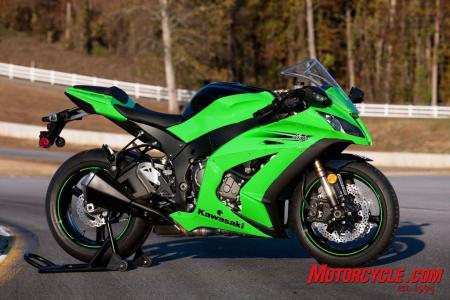 2011 ZX-10R: The most kick-ass Ninja to date. 2011 ZX-10R: The most kick-ass Ninja to date. |
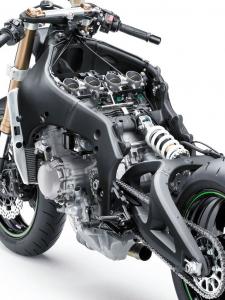 The 10R is powered by an entirely new engine producing as much as 170 hp at the wheel.
The 10R is powered by an entirely new engine producing as much as 170 hp at the wheel. Camshafts are now made from chromoly steel rather than cast iron. A soft-nitriding treatment that Kawi revised for the new camshafts reduces deflection (an �untruing� if you will, of the straightness of the camshaft) during the metal hardening process by upwards of 30-40%, according to Kawi. Cam lift and valve overlap are increased as part of the update � a move generally used to increase peak power.
All this rather dry talk of cams gives us some early insight to how intent Kawasaki is about rebirthing the 10R�s total package.
Valve tappets are designed to work with the new high-lift cams, and the intake valves� diameters are increased to 31mm from 30mm for improved cylinder-filling efficiency. The exhaust valves (in the head) are the same size, but stronger valve springs are employed all �round.
Cylinder intakes have increased volume and are hand-ported, while, according to Kawasaki's Rob Taylor, the exhaust ports are redesigned to reduce engine braking and allow the rider better control over the bike via more precise throttle control. Piston skirt size was minimized for the sake of reducing engine noise. Use of �dummy� heads bolted in place during cylinder boring means a more accurate machining process.
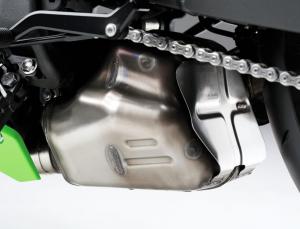 A new larger volume exhaust pre-chamber aids in centralizing mass and allows use of a smaller muffler.
A new larger volume exhaust pre-chamber aids in centralizing mass and allows use of a smaller muffler.So what�s all this strengthening, lightening and improved efficiency in the top half of the ZX�s new inline-Four really mean to you? A faster, stronger engine on the racetrack � the place Kawasaki hopes the Ninja will wage a successful war.
But, hey, if you�ll only ever terrorize twisty roads with the new 10R, all this high-performance tweaking should pay dividends for you, too, on your quest to conquer the canyons.
KIBS, it has nothing to do with MIBs (Men in Black)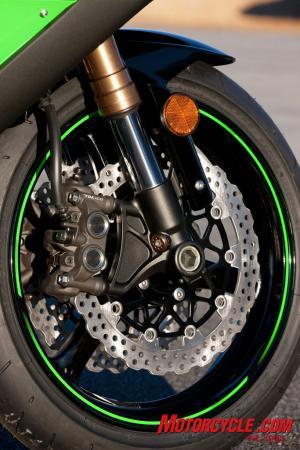 Kawasaki�s version of ABS for its high performance sportbike adds only 6 lbs to the bike�s weight and is said to help reduce rear wheel lift and hop under heavy braking. The updated calipers on the non-ABS bike we tested at Road Atlanta performed well, with good feel and power. Kawasaki�s version of ABS for its high performance sportbike adds only 6 lbs to the bike�s weight and is said to help reduce rear wheel lift and hop under heavy braking. The updated calipers on the non-ABS bike we tested at Road Atlanta performed well, with good feel and power.According to Kawasaki, a 2011 ZX-10R with ABS has a curb weight of 443 lbs while a non-ABS model weighs a hair less than 437 lbs. If we take Team Green at its word, that�s a savings of 21 lbs compared to the 458 lbs we measured on the fully fueled, ready-to-ride, 2010 ZX-10R we rode in our 2010 Literbike Shootout. This puts the new ZX in a tie with the 2010 CBR1000RR (437 lbs) � the lightest bike in that shootout. In ABS trim the Ninja is now about 10 lbs lighter than an S1000RR with ABS (453 lbs as measured). KIBS does the most basic of ABS functions by monitoring brake fluid pressure in the front calipers, but it goes one step further. With the fuel injection ECU feeding the ABS data about clutch actuation, gear position, engine speed, and throttle position, the anti-lock system is able to accommodate for �excessive� rear wheel lift during downshifts while under heavy front braking. If the rear wheel starts to hop, the system will bleed off pressure in the front brake to help stabilize the bike. And of course it monitors the front wheel like most basic anti-lock systems in order to prevent lockup. Without going into specifics, Kawi says we can expect to eventually see this new ABS, or something similar, on others models. Unfortunately, we weren�t able to test the KIBS system at the 10R�s launch, as ABS-equipped bikes will be built later in the production run. Stay tuned for a full test of ZX-10R ABS in the near future. |
Like the camshafts, the crankshaft and connecting rods use stronger materials for increased durability, while a new secondary engine balancer aids in reducing vibes. The cassette design of a new six-speed trans makes trackside gear swaps easier; Kawasaki is making seven different sets available. And in the name of ever-popular mass centralization, the crankshaft is oriented higher relative to the transmission�s output shaft.
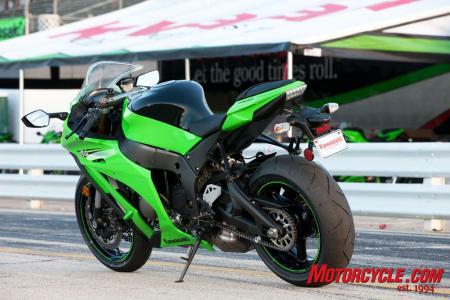 The 10R�s sleeker, more compact design had many riders drawing parallels to the shape and size of 600cc supersports. The 10R�s sleeker, more compact design had many riders drawing parallels to the shape and size of 600cc supersports. |
Part of the ZX-10R�s sleeker, restyled bodywork includes accommodating a new ram-air intake now placed more directly between the headlights. A larger 2.4-gallon airbox sucks air through a filter with 48% more surface area. Redesigned intake ducts work with the new airbox for increased engine performance, specifically in the mid- and high-rpm range.
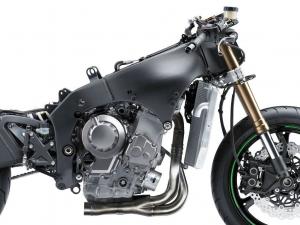 An all-new frame and swingarm are torsionally stiffer than the previous model�s chassis.
An all-new frame and swingarm are torsionally stiffer than the previous model�s chassis.A new, smaller EFI control unit, mounted inside the new airbox, tells a new (and of course lighter) fuel pump to flush petrol through new 12-hole Mitsubishi primary injectors into new 47mm (4mm larger) Keihin throttle bodies, now with larger oval sub-throttle valves. The need to manually adjust idle speed is eliminated by an ISC (idle speed control) valve set automatically to 1100 rpm. Kawasaki says this helps the bike run better from stops while the engine is still cold.
New ignition coils with secondary current bumped up by 12% provide more efficient fuel mixture burning.
The inline-Four spews carbon emissions through a new, hydroformed titanium exhaust header that�s 2.6 lbs lighter for this year. The exhaust valve in the pre-chamber (collector) is reworked to aid in reducing noise emissions and optimize engine performance. A benefit of the larger volume collector is a smaller and lighter stainless steel muffler.
Stiffer and lighter
Carrying the Ninja�s all-new engine is an all-new chassis.
The cast-aluminum twin-spar frame is constructed of fewer pieces, which means less welding which means increased strength � by slightly more than a 7% increase in torsional rigidity, although stiffness in the swingarm pivot area was reduced to allow for more stable cornering. Steering geometry is somewhat edgier, with rake at 0.5 degree shallower than the previous model�s 25.5 degrees, while the trail figure of 4.21 inches is shorter than last year�s 4.33 inches.
The new three-piece swingarm is also more rigid, by 18.5%, and is marginally lighter, too.
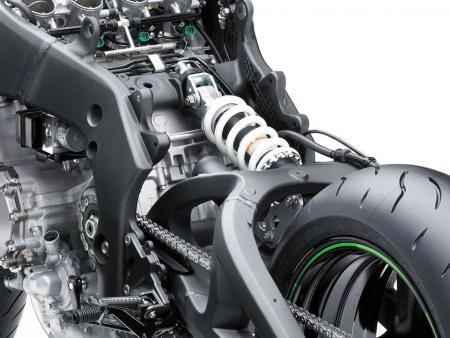 The new horizontal position of the shock helps keep the bike more compact overall. The new horizontal position of the shock helps keep the bike more compact overall. |
Last year�s ZX had a seat height of 32.7 inches; the new model�s seat is lower by a scant 10mm, so Kawi�s listed height of 32.0 inches doesn�t quite jive with the math, but it�s so close, who�s countin�?
Clip-ons have a more downward angle this year, while the footpegs� standard position is 5mm lower and 2mm further forward. For street-riding comfort, the adjustable pegs may be lowered an additional 15mm.
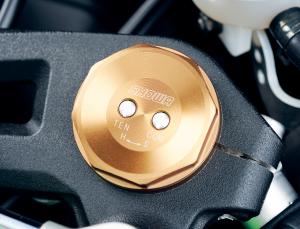 The ZX-10R now uses Showa�s innovative BPF. Following in little ZX-6R brother�s footsteps, so to speak
The ZX-10R now uses Showa�s innovative BPF. Following in little ZX-6R brother�s footsteps, so to speakSpinning at each end of the Ninja are new wheels lighter than last year�s hoops, trimming a significant 1.4 lbs of unsprung spinning mass � 11.2 oz from the front wheel, 11.3 oz from the rear. The U.S.-spec 2011 ZX-10R will wear Bridgestone�s BT-016 tire in the usual 120/70 and 190/55 sizes.
The four pistons in each of the two front brake calipers are now 30mm, where on last year�s bike it was two pistons at 32mm and two pistons at 30mm. Kawasaki says the equal sizing provides more stable brake performance. The rear caliper is also revised; a single 30mm piston (formerly 38mm) squeezes the rear rotor, and the piston in the master cylinder has increased size to 14mm (previously 12.7mm).
Brains! Braiins! Braiiiins! The smartest ZX-10R yet?
Climb aboard a 2011 ZX-10R and you sitting astride what is likely the most intelligent Kawasaki street bike ever made.
This new super sled, as expected, is equipped with traction control, rider-selectable power modes and (optional) ABS. Of these three systems, it�s the TC that impresses most for its simplicity and effectiveness. Furthermore, this is the first production TC on a Japanese sportbike.
Unlike KTRC (Kawasaki TRaction Control) first seen on the 2010 Concours 14 � a TC system that�s essentially a safety feature � the 10R�s S-KTRC (Sport-KTRC) is far less intrusive, with the ultimate goal of allowing you to ride faster.
A rider can choose from three levels of TC (1,2 or 3), with setting 1 as the least intrusive; you can switch TC off entirely as well. All three modes are switchable while in motion as long as the throttle is closed. Disabling TC requires the bike be at a stop.
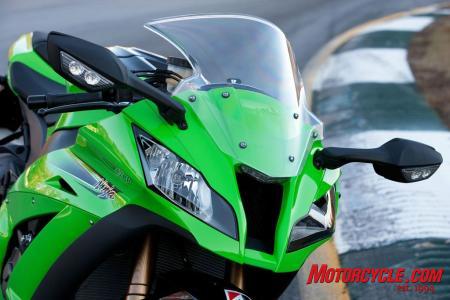 Redesigned ram-air intake joins new headlight and mirror-integrated signal designs to create a sharper, more focused look for the big Ninja. Redesigned ram-air intake joins new headlight and mirror-integrated signal designs to create a sharper, more focused look for the big Ninja. |
The 10R�s brain calculates data from the throttle position sensor (TPS), which it sees as what the rider wants the bike to do in terms of accelerating, the rate of engine acceleration, gear position and info from front and rear wheel-speed sensors.
By comparing the rate of change between the data from sensors every 5 milliseconds, the TC can, as Kawasaki says, �predict� your intended path of travel so to speak. It will create an engine map(s), plotting out in advance how the map should go based on sensor data compared to the rider�s wishes � or more accurately, TPS data. If a dramatic change in data occurs, and the TC analyzes this change will result in a major deviation from the map it had planned, it will remap accordingly.
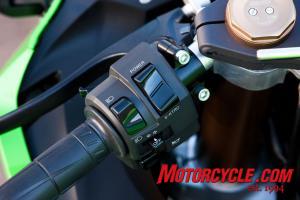 Accessing traction control and power modes is a simple matter of toggling one switch.
Accessing traction control and power modes is a simple matter of toggling one switch.If this involuntary torque production sounds like a hazardous two-wheeled version of 2001: A Space Odyssey, rest assured the TC system won�t dump an extra truckload to the rear wheel at the worst possible time. Taylor used a hypothetical scenario in which the TC might boost torque by a foot-pound or two in order to achieve its goal of keeping you steaming ahead, �going forward in time,� as he often phrased it.
Because S-KTRC doesn�t use a fixed set of parameters for reeling in the engine to minimize loss of traction (as Kawasaki says its competitors do), the Kawi system is able to adjust engine mapping (torque production) on the fly.
Rather than simply and abruptly chopping power as a way to address the problem; S-KTRC adapts, it�s proactive. Therefore, the TC allows a rider to power slide or power wheelie in a predictable manner so long as the bike is moving forward �in time.� If wheel spin, or another action, results in the bike slowing, TC will step in to correct the issue.
S-KTRC even allows for deliberate wheelies. The system will disregard input from the front wheel sensor if there�s a rapid rate of change in front wheel speed, like when you flip the clutch lever and hammer the throttle to purposely hoist the front-end skyward, but again, so long as you�re not slowing down as a result of your hooliganism.
The idea that a TC system can adapt to conditions rather than merely react seems a bit sci-fi, and the above is an oversimplification of how it works. But it�s a safe bet that if this system hadn�t performed well enough for Kawasaki in MotoGP over the past five years we wouldn�t see it, or a version of thereof, today on the new 10R.
F is for full power; M (Variable Middle mode) allows 75% of full power with a milder power curve but will allow access to full power depending on the throttle�s rate of change. If, for example, you whack the throttle open, the ECU will give you full power and then revert to M mode again when you�ve eased back on the power. L mode is for low power and only allows 60% of power at all times.
Like the TC, power modes are switchable on the fly as long as the throttle is closed for the brief second or so necessary, and it doesn�t require clutch lever engagement like the S1000RR requires.
Power mode and TC selector switches are integrated into a single, large toggle switch on the left switchgear housing: S-KTRC is on the bottom half, power mode on the top. Lastly, making a change to TC doesn�t alter power mode settings and vice versa. Selections are independent of one another, unlike on BMW�s S1000RR that comingles or creates combinations with its DTC (Dynamic Traction Control) and power modes.
| The Zed�s flashy new dash! A new instrument cluster for the ZX rivals the complexity of Ducati�s MotoGP-derived instruments, and it�s much prettier, too! A prominent LED (not lesser-contrast LCD) bar-graph tachometer doubles as a programmable shift light that can pulse or flash at a couple different rates of your choosing and will change from yellow to red at the shift point. Also, the tachometer LEDs are colored rather than just backlit with color, and you can adjust LED intensity or allow the ambient light sensor on the dash to adjust them automatically.
In Race mode, gear position takes center stage where road speed is normally displayed; the mph display takes the clock�s position in the lower right, and the odometer becomes a lap timer. With TC enabled, and regardless of which view you have the instrument set, a graduated bar graph at the bottom center of the screen indicates TC activation. No bars displayed, naturally, means traction control isn�t currently in play. But when it does activate, the segmented bar graph will increase and decrease as an indicator of how much S-KTRC is working to prevent you and your new bike from wadding up. |
As I railed �round Road Atlanta, I experienced firsthand the TC�s liberal nature as it allowed me to access as much of the new engine�s ferocious power as I could handle.
As the tire wore in a predictable manner, TC level 2 allowed enough movement from the rear end that I was able to confidently ride through the powerslides and spins while in Full power mode.
I attribute my need to endure a learning curve for a track I�d never ridden before as the reason I rarely saw TC activation while in Level 1, the least intrusive setting.
Road Atlanta has a number of blind corner entries complicated by elevation changes (read: hills!), so I fully admit to wussing out at times. My sense of self-preservation was the likely culprit that wouldn�t allow me to pin the throttle to the stops on an engine wailing out over 170 hp at the wheel. Guilty as charged.
For the warmer afternoon sessions Bridgestone�s BT-003 Type II Pro was fitted. This tire uses an additional belt, and is thereby longer wearing due to its stiffer carcass. This new, medium-compound rear tire offered improved feedback, and I didn�t see as much activation from the TC as I did when using the softer compound tire from the morning sessions.
Perhaps the best quality of S-KTRC is its transparent-at-times nature. Not once during my ride did it cut in abruptly and cause the bike to stumble and sputter, even when in level 3. The system�s activation is notably seamless and not nearly as assertive as Ducati�s DTC.
Just as thrilling as Kawi�s new TC was to use, I was equally stoked by the new chassis� performance.
Steering effort is as light as on the previous model, but the new bike has a much more linear, fluid motion from upright to knee-on-the-deck time. There weren�t any surprises in handling, like the falling into a corner feeling I experienced occasionally on last year�s model.
The new engine is a screamer. While mid-range power is solid and smooth, the new mill seems to come on the cam around 11,000 rpm with a forceful rush of power all the way to redline. So potent is the new mill that on occasion high-rpm upshifts nearly resulted in the clip-ons being yanked out of my hands at 120-plus mph.
Raising the literbike bar� again!
To this point in TC development for mass-market use, Kawasaki�s S-KTRC on a wholly revamped bike turning out rear wheel power close to that of the BMW, makes an MSRP only $1000 more than last year�s price of $12,799 seem like Team Green is giving the 2011 ZX-10R away for a song.
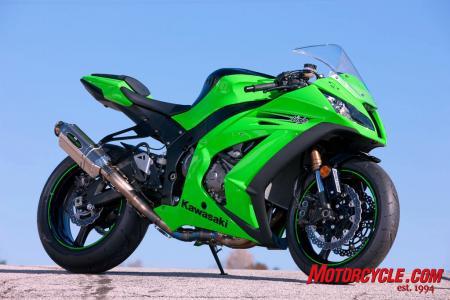 The 2011 ZX-10R is poised to create trouble for BMW�s year-old S1000RR entrant in the literbike wars. And it�s the most advanced of the liter machines from the Big Four. Seen here with a full Nassert-Beet exhaust and proprietary Kawi race-kit ECU as the only hop-ups, the new 10R is said to produce over 180 hp from a stock engine. The new Ninja is basically race-ready out of the box. The 2011 ZX-10R is poised to create trouble for BMW�s year-old S1000RR entrant in the literbike wars. And it�s the most advanced of the liter machines from the Big Four. Seen here with a full Nassert-Beet exhaust and proprietary Kawi race-kit ECU as the only hop-ups, the new 10R is said to produce over 180 hp from a stock engine. The new Ninja is basically race-ready out of the box. |
Honda, Suzuki and Yamaha had better step up their game ASAP or risk a shrinking profile in the literbike wars.
U7XGUEXFP2EE

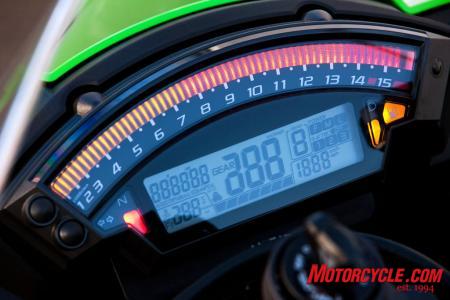 The ZX�s new dash is a leaps-and-bounds improvement over the prior 10R�s dash.
The ZX�s new dash is a leaps-and-bounds improvement over the prior 10R�s dash.
No comments:
Post a Comment